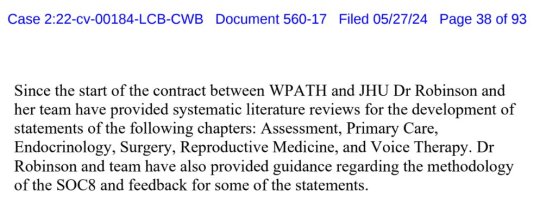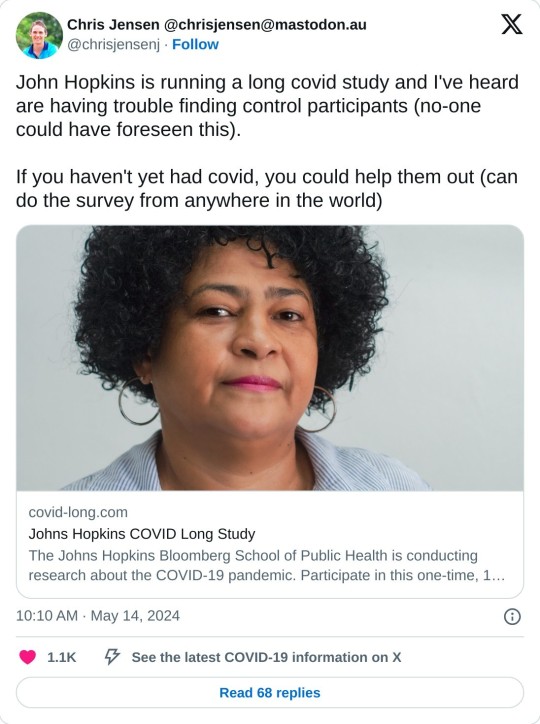#johns hopkins university
Explore tagged Tumblr posts
Text
By: Jesse Singal
Published: Jun 27, 2024
In April Hilary Cass, a British paediatrician, published her review of gender-identity services for children and young people, commissioned by NHS England. It cast doubt on the evidence base for youth gender medicine. This prompted the World Professional Association for Transgender Health (WPATH), the leading professional organisation for the doctors and practitioners who provide services to trans people, to release a blistering rejoinder. WPATH said that its own guidelines were sturdier, in part because they were “based on far more systematic reviews”.
Systematic reviews should evaluate the evidence for a given medical question in a careful, rigorous manner. Such efforts are particularly important at the moment, given the feverish state of the American debate on youth gender medicine, which is soon to culminate in a Supreme Court case challenging a ban in Tennessee. The case turns, in part, on questions of evidence and expert authority.
Court documents recently released as part of the discovery process in a case involving youth gender medicine in Alabama reveal that WPATH's claim was built on shaky foundations. The documents show that the organisation’s leaders interfered with the production of systematic reviews that it had commissioned from the Johns Hopkins University Evidence-Based Practice Centre (EPC) in 2018.
From early on in the contract negotiations, WPATH expressed a desire to control the results of the Hopkins team’s work. In December 2017, for example, Donna Kelly, an executive director at PATH, told Karen Robinson, the EPC's director, that the WPATH board felt the EPC researchers “cannot publish their findings independently”. A couple of weeks later, Ms Kelly emphasised that, “the [WPATH] board wants it to be clear that the data cannot be used without WPATH approval”.
Ms Robinson saw this as an attempt to exert undue influence over what was supposed to be an independent process. John Ioannidis of Stanford University, who co-authored guidelines for systematic reviews, says that if sponsors interfere or are allowed to veto results, this can lead to either biased summaries or suppression of unfavourable evidence. Ms Robinson sought to avoid such an outcome. “In general, my understanding is that the university will not sign off on a contract that allows a sponsor to stop an academic publication,” she wrote to Ms Kelly.
Months later, with the issue still apparently unresolved, Ms Robinson adopted a sterner tone. She noted in an email in March 2018 that, “Hopkins as an academic institution, and I as a faculty member therein, will not sign something that limits academic freedom in this manner,” nor “language that goes against current standards in systematic reviews and in guideline development”.
Not to reason XY
Eventually WPATH relented, and in May 2018 Ms Robinson signed a contract granting WPATH power to review and offer feedback on her team’s work, but not to meddle in any substantive way. After WPATH leaders saw two manuscripts submitted for review in July 2020, however, the parties’ disagreements flared up again. In August the WPATH executive committee wrote to Ms Robinson that WPATH had “many concerns” about these papers, and that it was implementing a new policy in which WPATH would have authority to influence the EPC team’s output—including the power to nip papers in the bud on the basis of their conclusions.
Ms Robinson protested that the new policy did not reflect the contract she had signed and violated basic principles of unfettered scientific inquiry she had emphasised repeatedly in her dealings with WPATH. The Hopkins team published only one paper after WPATH implemented its new policy: a 2021 meta-analysis on the effects of hormone therapy on transgender people. Among the recently released court documents is a WPATH checklist confirming that an individual from WPATH was involved “in the design, drafting of the article and final approval of [that] article”. (The article itself explicitly claims the opposite.) Now, more than six years after signing the agreement, the EPC team does not appear to have published anything else, despite having provided WPATH with the material for six systematic reviews, according to the documents.
No one at WPATH or Johns Hopkins has responded to multiple inquiries, so there are still gaps in this timeline. But an email in October 2020 from WPATH figures, including its incoming president at the time, Walter Bouman, to the working group on guidelines, made clear what sort of science WPATH did (and did not) want published. Research must be “thoroughly scrutinised and reviewed to ensure that publication does not negatively affect the provision of transgender health care in the broadest sense,” it stated. Mr Bouman and one other coauthor of that email have been named to a World Health Organisation advisory board tasked with developing best practices for transgender medicine.
Another document recently unsealed shows that Rachel Levine, a transwoman who is assistant secretary for health, succeeded in pressing WPATH to remove minimum ages for the treatment of children from its 2022 standards of care. Dr Levine’s office has not commented. Questions remain unanswered, but none of this helps WPATH’s claim to be an organisation that bases its recommendations on science.
[ Via: https://archive.today/wJCI7 ]
--













==
So, there are 6 completed reviews sitting somewhere, that WPATH knows shows undesirable (to them) results. And they know it. And despite - or perhaps, because of - that, they wrote the insane SOC8 anyway. And then, at the behest of Rachel Levine, went back and took out the age limits, making it even more insane.
This isn't how science works, it's how a cult works.
When John Templeton Foundation commissioned a study on the efficacy of intercessory prayer, a study which unsurprisingly found that it's completely ineffective, it was forced to publish the negative results.
So, even the religious are more ethical than gender ideologues when it comes to science. This is outright scientific corruption.
#Jesse Singal#Johns Hopkins#Johns Hopkins University#WPATH#World Professional Association for Transgender Health#anti science#gender cult#corruption#medical malpractice#medical corruption#medical scandal#systematic review#Cass review#Cass report#gender affirming care#gender affirming healthcare#gender affirmation#ideological corruption#religion is a mental illness
266 notes
·
View notes
Text

By tweaking materials, scientists create transistors that remember
A team of Johns Hopkins materials scientists made a surprising discovery that could change the way memory works in electronics. By tweaking the materials used in organic material-based logic switches called transistors, they created a new kind of memristor—devices that can remember past charging states when a current passes through it—suggesting the potential for developing electronic memory systems that mimic the way human brains work. Their results appear in Advanced Functional Materials. "Initially, our goal was to understand what happens during transistor charging," says team member and graduate student Riley Bond. "We wanted to pinpoint where the charge is trapped in these transistors and improve the device's overall charging capabilities, ensuring the transistors didn't short circuit when voltage was added."
Read more.
30 notes
·
View notes
Text
Guys I restarted watching Hannibal (30 minutes ago) and you're TELLING ME HANNIBAL AND HOUSE WENT TO THE SAME GODDAMN MED SCHOOL.
All roads lead to Johns Hopkins medical school
According to my math they barely missed eachother by a few years BUT! I may be wring since I remember hannibal being an early grad or something similar
ANYWAYS GUYS I NEED A HOUSE MD X HANNIBAL CROSSOVER NOW!!!!
#malpractice md#house md#gregory house#johns hopkins university#hannibal#hannibal lecter#mads mikkelsen#Alex autisming
41 notes
·
View notes
Text

Student June Bronfenbrenner at an early Xerox machine photocopying a book, Milton S. Eisenhower Library, Johns Hopkins University, Baltimore, Maryland, 1976.
#technology#photocopier#Xerox#library#June Bronfenbrenner#Milton S. Eisenhower Library#Johns Hopkins University#Baltimore#Maryland#USA#1976
144 notes
·
View notes
Text
35 notes
·
View notes
Text

I WILL be an anesthesiologist
˚ ༘♡ ⋆。˚
#anesthesiologist#anesthesiology#manifesting#johns hopkins university#future#good grades#manifesation#i will be an anesthesiologist#pink aesthetic#moodboard#current mood#type shit#academic weapon#medicine#healthcare#hospital#medicare#filipino#philippines#make my parents proud#viralpost#hopecore#hopefully#faith#i want an innocent love the rest of time#smart girl#i know what i want and i’m gonna get it#˚ ༘♡ ⋆。˚
8 notes
·
View notes
Text
Johns Hopkins University is at the forefront of robotic surgery research and development
3 notes
·
View notes
Text
LAST DAY TO FILE - 12/17/2024 (today)
DID YOU GO TO A "TOP TIER" UNIVERSITY? DID YOU RECEIVE SOME FINANCIAL AID? FILE TODAY TO RECEIVE COMPENSATION!!!
Closes at 11:59:59 Pacific Time
Got mine in at the last minute as per usual. Sending out anyway in case anyone else wants to scramble to get things together today.
#get that money if you deserve it!#class action lawsuit#schools listed below#brown university#university of chicago#columbia university#dartmouth college#dartmouth#duke university#emory university#emory#northwestern university#william marsh rice university#vanderbilt#yale#yale university#caltech#california institute of technology#georgetown university#johns hopkins university#johns hopkins#mit#massachusetts institute of technology#university of notre dame#university of pennsylvania#financial aid
4 notes
·
View notes
Text
By Bayani
This year, the Baltimore Peoples Power Assembly held its annual International Workers’ Day celebration at the newly established Palestine solidarity encampment at Johns Hopkins University. About a hundred already supporting the encampment were joined by hundreds more.
#MayDay2024#PPA#Baltimore#gaza solidarity encampment#protest#johns hopkins university#Struggle La Lucha
10 notes
·
View notes
Text
Lupe Fiasco to Join Faculty at Johns Hopkins University's Peabody Institute as They Launch Hip-Hop Program
In recognition of the enduring cultural importance of hip-hop, the Peabody Institute of the Johns Hopkins University announced it will launch the first-ever Bachelor of Music in Hip Hop program, fittingly bringing the first undergraduate hip-hop degree to the first conservatory in the United States. Led by composer, producer, beatmaker, pianist, and professor Wendel Patrick, inaugural faculty…
2 notes
·
View notes
Text
Anyone know where I can get a second hand Johns Hopkins University teddy bear or plushy, like the kind that they sell around graduation and such? My friend had such a miserable time fighting the constant ableism of JHU's staff and inaccessible building infrastructure that I want to get her dog a JHU toy to maul for Christmas (without actually giving money to JH). I can't find anything on ebay but clothing.
#seriously i don't know a single alumnus disabled or abled that didn't have an awful time at JHU#johns hopkins#Johns hopkins University
12 notes
·
View notes
Text

Researchers report pathway to stronger alloys for extreme environments
At around 2,500 degrees Fahrenheit, steel melts. When aluminum is exposed to moisture and oxygen, it corrodes. While these conventional alloys are well suited to everyday environments, they fold under abnormally excessive exposure to extreme heat, cold, pressure and other conditions. And with the nation conducting more and more operations in extreme environments, such as space and the Arctic, the need for alloys that maintain strength under these conditions is critical. Multi-principal element alloys (MPEAs), which are made up of several elements in roughly equal proportions, can be better suited for extreme environments because their high strength, hardness and toughness over a range of temperatures. In addition, MPEAs often exhibit excellent corrosion resistance and thermal stability, and can display unique functional properties useful for electronic or magnetic devices.
Read more.
#Materials Science#Science#Alloys#High temperature materials#High entropy alloys#High entropy materials#Johns Hopkins University
11 notes
·
View notes
Text
#johns hopkins university#Bloomberg school of public health#cannabis#marijuana#weed#pot#legalization#medical marijuana#mmj#medical cannabis#legalize
3 notes
·
View notes
Text
Science, bitches.
I got my first lot only a couple months ago so I'm out. Please help if you can. Any country, any place.

if you have not had covid yet please help out science and complete this survey - https://covid-long.com/
#covid 19#long covid#if you haven't had covid PLEASE help science#science#johns hopkins university#study
16K notes
·
View notes
Text
Rebel Falls: Uncovering Civil War Secrets
Today’s guest is Tim Wendel, an award-winning author, sportswriter, and Writer-in-Residence at Johns Hopkins University. In this engaging interview, Tim discusses his new book, “Rebel Falls,” where he weaves together fiction and history to tell the story of Rory Chase, a brave Union spy inspired by real women from the Civil War. Betsy and Tim dive into the fascinating history of Confederate…
#kickalzheimersassmovement#Betsy Wurzel#Civil War#Civil War Spy#Johns Hopkins University#Secrets#Sportswriter#Spy#Tim Wendel#Underground Railroad
0 notes